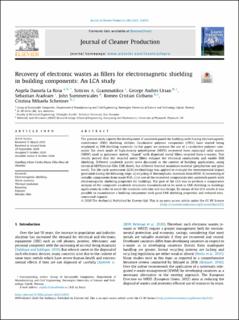| dc.contributor.author | La Rosa, Angela Daniela | |
| dc.contributor.author | Grammatikos, Sotirios | |
| dc.contributor.author | Ursan, George Andrei | |
| dc.contributor.author | Aradoaei, Sebastian | |
| dc.contributor.author | Summerscales, John | |
| dc.contributor.author | Ciobanu, Romeo Cristian | |
| dc.contributor.author | | |
| dc.contributor.author | Schreiner, Cristina Mihaela | |
| dc.date.accessioned | 2021-01-11T12:54:56Z | |
| dc.date.available | 2021-01-11T12:54:56Z | |
| dc.date.created | 2020-11-24T15:00:16Z | |
| dc.date.issued | 2020 | |
| dc.identifier.issn | 0959-6526 | |
| dc.identifier.uri | https://hdl.handle.net/11250/2722394 | |
| dc.description.abstract | The present study reports the development of sandwich panels for building walls having electromagnetic interference (EMI) shielding abilities. Conductive polymer composites (CPCs) have started being employed as EMI shielding materials. In this paper we propose the use of a conductive polymer composite flat sheet made of high-density polyethylene (HDPE) recovered from municipal solid wastes (MSW) used as polymeric matrix, “doped” with dispersed metal fillers recycled from e-wastes. Test results proved that the recycled metal fillers enhance the electrical conductivity and enable EMI shielding. Different sandwich panels were discussed in the context of building applications, using identical HDPE/metal-filler EMI sheets, but different thermal insulation material (polystyrene and glass wool). The life cycle assessment (LCA) methodology was applied to evaluate the environmental impact generated during the following steps: a) recycling of thermoplastic materials from MSW; b) recovering of metallic components from waste PCB; c) re-use of the recovered components into sandwich panels with electromagnetic shielding properties for buildings. The goal of the LCA was to perform a comparative analysis of the composite sandwich structures manufactured to be used as EMI shielding in buildings applications in order to assist the materials selection and eco-design. By means of the LCA results it was possible to manufacture a building component with good EMI shielding properties and reduced environmental impacts. | en_US |
| dc.language.iso | eng | en_US |
| dc.publisher | Elsevier | en_US |
| dc.rights | Navngivelse 4.0 Internasjonal | * |
| dc.rights.uri | http://creativecommons.org/licenses/by/4.0/deed.no | * |
| dc.title | Recovery of electronic wastes as fillers for electromagnetic shielding in building components: An LCA study | en_US |
| dc.type | Peer reviewed | en_US |
| dc.type | Journal article | en_US |
| dc.description.version | publishedVersion | en_US |
| dc.source.journal | Journal of Cleaner Production | en_US |
| dc.identifier.doi | https://doi.org/10.1016/j.jclepro.2020.124593 | |
| dc.identifier.cristin | 1851769 | |
| dc.description.localcode | ©2020 The Author(s). Published by Elsevier Ltd. This is an open access article under the CC BY license (http://creativecommons.org/licenses/by/4.0/).Journal of Cleaner Production 280 (2021) | en_US |
| cristin.ispublished | false | |
| cristin.fulltext | original | |
| cristin.qualitycode | 2 | |

